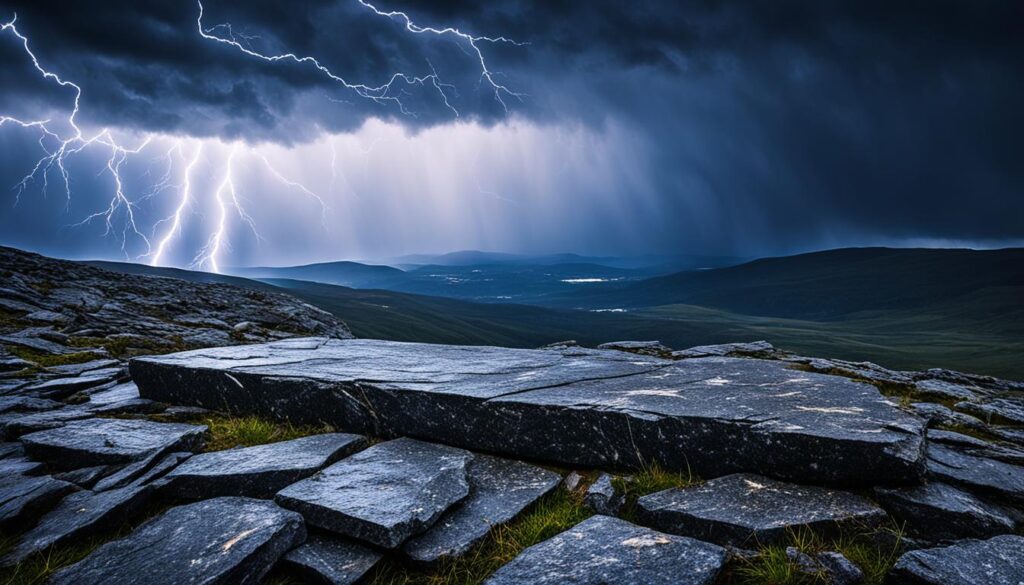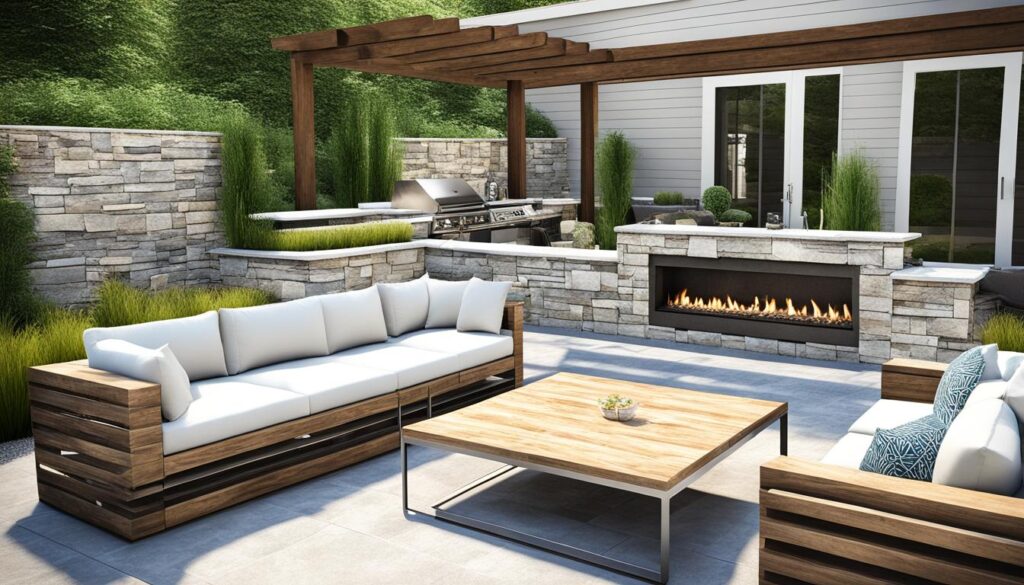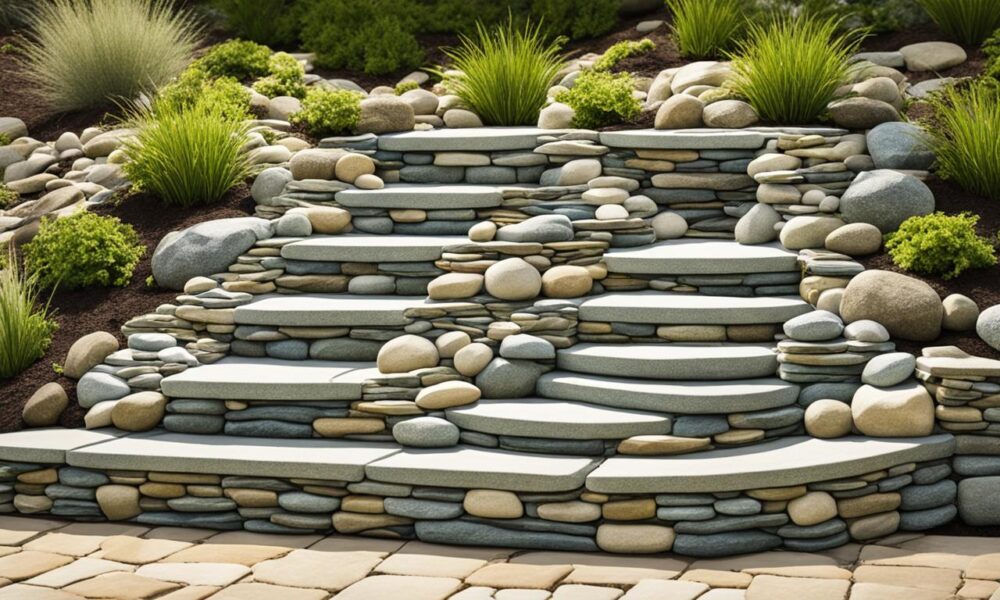Find Your Perfect Outdoor Stone Finish
Natural stone tiles are known for their toughness and many looks. They’re great for spicing up outdoor spots like patios and courtyards.
When choosing, homeowners need a good guide. This helps make sure the stone can handle different weather. It also helps it blend well with the garden, adding both charm and usefulness.
Key Takeaways
- Patio stone options include granite, quartzite, and porcelain.
- Granite is porous and requires sealing to avoid staining and moisture damage.
- Quartzite is non-porous, harder than granite, and may be more expensive.
- Porcelain is colorfast, weather-resistant, and low maintenance.
- Thicker slabs (around 3cm) are recommended for outdoor countertops for durability.
- Darker stones can get hot in the sun.
- Dense, non-porous stones like quartzite are better suited for outdoor use than porous stones like marble.
Assessing Your Outdoor Space for the Ideal Stone Finish
When choosing a stone finish for outdoors, think about the area and its weather. Different stones react differently to heat, cold, and wetness. It’s wise to select a stone that can handle the environment well.
Location and Climate Considerations
Granite tiles are tough and handle weather changes well, perfect for outdoor areas. Marble tiles look elegant but may not last in harsh weather. They come in many colors, from white to black.
Slate tiles give a lot of character with their varied colors and textures but are not as durable. Limestone is beautiful but can crack in cold weather and wear out in busy places. Travertine is warm and golden but more delicate; it suits calm, low-traffic areas better.
Impact of Light Exposure
Light can also change the look of outdoor stones. Stones in direct sunlight might lose their color. Choosing stronger, darker stones like granite or slate can help them keep their looks. This way, your outdoor space will remain beautiful with minimal work.
Knowing how different stone finishes react to light and weather can guide your decisions. This knowledge can improve not only the look but also the practicality of your outdoor area.
Understanding the Different Types of Natural Stone
Picking the right natural stone type for outdoor areas can make them look and work better. An informed guide on outdoor stone finishes is key. It helps homeowners balance beauty with function using different natural stones for outdoor projects.
Key Characteristics of Granite, Slate, Limestone, and More
Granite, slate, and limestone have special features that make them great for outdoor spaces. It’s important to know these features when picking outdoor stone types:
- Granite: Granite is known for being able to handle heat and last a long time. It’s also good at not being too slippery.
- Slate: Slate is chosen for its ability to prevent slipping and its toughness against bad weather. It’s not smooth, which keeps it from being too slippery.
- Sandstone: Sandstone has a natural aesthetic and is not very slippery, thanks to its grainy surface.
- Marble: Marble looks classic and has beautiful veins. Some marbles can be used outdoors with the right care, despite what many think.
Best Uses for Different Stone Types
Figuring out the best way to use each stone type helps you get the most out of them. The outdoor stone finishes guide offers tips like these:
| Stone Type | Key Characteristics | Best Uses |
|---|---|---|
| Granite | Durability, Heat Resistance | Patios, Paths, BBQ Areas |
| Slate | Slip Resistance, Weather Resilience | Pool Surrounds, Steps |
| Sandstone | Natural Aesthetic, Slip Resistance | Walkways, Garden Edges |
| Marble | Prominent Veining, Elegant Look | Outdoor Kitchens, Decorative Features |
Knowing these characteristics and uses is at the heart of a good outdoor stone finishes guide. It equips homeowners to meet their outdoor space’s look and use needs smartly.
Evaluating Durability and Weather Resistance
Choosing natural stone for outdoor projects means looking at how well it lasts and handles weather. Durable stone finishes are key to keeping outdoor areas looking good and working well for a long time.

Freeze-Thaw Cycle Impacts
In places with changing temperatures, the freeze-thaw cycle is a big deal. Stones that soak up water can break when it freezes and thaws. So, it’s important to pick natural stone that can handle these cycles to avoid problems like cracks.
- Granite: It’s great at resisting freeze-thaw cycles because it doesn’t absorb much water.
- Slate: It’s very durable against cold and wet conditions.
- Sedimentary stones, such as limestone: They do better in spots with mild temperature changes.
Moisture and Heat Resistance
How well natural stone deals with moisture and heat is key to its durability. Stones like granite and slate, which don’t soak up much water, last a long time. They can also deal with big changes in temperature and stay looking good.
- Granite: It’s top-notch at resisting moisture and handling high heat.
- Slate: It’s excellent against moisture and is heat-resistant, good for many climates.
- Sandstone: Has a natural look with good but not extreme moisture resistance, fit for moderate climates.
It’s a good idea to talk to a professional stone supplier or installer about your project. They can help you pick the right stone for what you need. This ensures your choice stays beautiful and strong over time.
Prioritizing Safety and Slip Resistance
To make outdoor areas safe, we choose the right stones to lower slip dangers. Textured granite, sandstone, and slate are great. They naturally reduce slipping because of their surfaces.
Choosing Slip-Resistant Surfaces
Granite is well-known for being strong and having a high COF. It’s great for outdoor areas. Slate works well too, with its rough surface keeping it less slippery, even when wet.
Sandstone is also good. It has a rough, grainy look that’s also slip-resistant. All these features make them perfect for outdoor areas where safety is key.
| Material | Slip Resistance | PTV (Pendulum Test Value) | R-TV (Ramp Test Value) |
|---|---|---|---|
| Granite | High | 38-64 | 24-35° |
| Slate | Very High | 40-65 | 28-36° |
| Sandstone | Moderate-High | 36-64 | 24-35° |
| Porcelain Paving | High | 50-70 | 35°+ |
Industry Standard Ratings for Slip Resistance
There are standard ratings to check the slip resistance of stones. For outdoor areas that get wet, we look for a PTV of 36 or more. Also, a R-TV of 35° shows there’s little risk of slipping.
Porcelain and concrete can be made even safer with textured finishes. This boosts outdoor tile safety. Composites are also used. They are both pretty and good at preventing slipping, fitting different places well.
To sum up, picking the right materials and following safety ratings are key. They make sure outdoor spaces are nice and safe for everyone.
Choosing the Right Natural Stone Finish for Your Outdoor Space
Choosing the right natural stone finish for your outdoor space is key. You need to think about durability and looks. Making a smart choice ensures your space not only looks great but lasts long too.
Tips for Selecting Durable and Attractive Stones
First, you need to know about the many stone types out there:
- Granite: It’s super tough and comes in many colors. This makes it a great pick for different styles.
- Marble: Marble comes in a range of colors. Hexagonal marble tiles can make a space look very elegant.
- Slate: Slate has unique colors and textures like grey, green, and brown. This adds a cool look to your outdoor space.
- Limestone: It brings a light, warm vibe with colors going from white to brown.
- Sandstone: Sandstone looks like wood but is strong like stone. It comes in many colors and patterns.
These stones are great for outdoor floors. They are strong and look nice. Think about the weather when picking a stone. You want it to hold up well in your climate.
Matching Stone Finishes with Patio Designs
Choosing the right stone finish means matching it with your patio design. This makes everything look like it fits together:
- Modern Design: Use granite for a sleek, modern look. Its colors fit well in many styles.
- Rustic Charm: Slate’s earthy colors are perfect for a rustic look. They blend well with natural materials.
- Elegance and Class: Unique marble tiles can make your patio look very luxurious. Don’t forget about hexagonal designs for a classy touch.
- Warm and Inviting: Limestone makes a space feel cozy and welcoming. Its tones are soft and inviting.
- Natural Look: Sandstone brings a natural vibe. It fits in perfectly with outdoor designs highlighting nature.
It’s smart to talk to a pro stone supplier or installer. They can help you pick the best stone for your space. This could save you money on future maintenance and repairs.
| Stone Type | Best For | Color Range |
|---|---|---|
| Granite | Modern Designs | White to Black |
| Marble | Elegant Spaces | White to Black |
| Slate | Rustic Charm | Grey, Green, Brown, Tan, Orange |
| Limestone | Warm, Inviting Areas | White to Brown |
| Sandstone | Natural Looks | Various |
Follow these tips to make your outdoor space both beautiful and long-lasting.
Aesthetic and Design Considerations
Think about how a well-chosen stone finish can make your patio look better. Matching the stones to the theme improves the outdoor area’s beauty. Look at the color, texture, and type of stone to blend them with your design.
Complementing Your Patio’s Overall Design Theme
Each type of stone finish creates a different feel for your patio. A polished look shines and works well for modern spaces. For a calm vibe, choose honed stone for its soft elegance. Textured stones bring a natural, earthy feel to your patio.

Choosing the right stone type, like Granite or Marble, is key for your patio design. Granite is durable and looks sleek. Limestone comes in warm tones that make a garden feel cozier.
Exploring Various Stone Finish Options
Taking time to look at different stone finishes is important. There are many to choose from, each offering a unique look.
| Stone Type | Finish | Description |
|---|---|---|
| Granite | Polished | Offers a high-gloss, reflective finish that enhances modern patio designs. |
| Marble | Honed | Features a smooth, non-reflective finish, ideal for elegant, understated patios. |
| Limestone | Textured | Provides a non-slip surface with a rustic, natural appearance. |
| Travertine | Tumbled | Has a weathered look with rounded edges, perfect for a vintage vibe. |
Finding the right stone and finish transforms your patio. Talk to experts to get advice on what fits your style and needs. This choice lasts long, is easy to care for, and looks great with your design.
Read more about choosing the perfect natural stone for your outdoor space.
Pros and Cons of Popular Stone Finishes
It’s key to find the best stone finish for your outdoor area. You want beauty without sacrificing ease of care and life span. Each finish has its own benefits and challenges. So, think about what you need and like.
Comparing Polished, Honed, and Textured Finishes
The choice you make on stone finish will really change how your outdoor area looks and works. I’ll compare polished, honed, and textured finishes for you.
| Finish Type | Pros | Cons |
|---|---|---|
| Polished Stone |
|
|
| Honed Stone |
|
|
| Textured Stone |
|
|
Long-Term Maintenance and Durability
Think about how hard it will be to keep up with maintaining the stone finish. Consider its durability too. These are crucial in picking the right finish for you.
Polished vs. honed stone finishes: Polished stones look elegant but need regular care to stay shiny. Honed finishes, on the other hand, are low-maintenance but can show stains easily.
Textured stone finishes: Textured finishes like leathered or flamed not only look good but also help with safety against slips. However, they need more cleaning to stay looking nice.
Choosing the perfect finish is about what matters most to you. Do you want something that’s easy to clean or something that’s safe against slips? By knowing these details, you can make the best choice for your outdoor area.
Best Practices for Installation and Maintenance
It’s key to have your outdoor stone finishes set up and kept right. This keeps them looking good and working well for a long time. Hiring pros for installation and following upkeep advice makes outdoor areas last longer and keep their beauty.
Professional Installation Tips
Getting pros to lay your outdoor stone is crucial. They understand the details and have the right skills and tools. For a perfect finish, keep these tips in mind:
- Plan and Prepare the Base: First, make sure the ground is flat and ready. This stops the stones from moving or sinking later.
- Select the Right Adhesive: Choose adhesives meant for outdoors and that work well with your stone type.
- Precision Cutting: Cut stones as needed to fit perfectly using the right tools.
- Grouting: Fill spaces between stones with the right grout, like sanded or unsanded.
- Allow Curing Time: Wait until the adhesive and grout are completely dry. This makes everything strong and stable.
Maintenance Guidelines for Different Stone Finishes
Each outdoor stone finish needs its own care. But, there are a few general tips for all:
- Sealing: Seal stones regularly to keep them from staining or scratching. Reapply sealer every few years.
- Cleaning: Use warm water and mild soap to clean. Avoid harsh cleaners that can harm the stone.
- Protection: Put coasters or pads under heavy items to protect the stone from damage.
- Periodic Inspections: Check your stones often for issues. Fix any problems right away to prevent more damage.
Stick to these tips for installation and keeping up with maintenance. Your outdoor stones will not only last longer but also remain beautiful and useful.
Here’s a summary of how to care for various outdoor stones:
| Stone Type | Installation Tip | Maintenance Strategy |
|---|---|---|
| Granite | Use a diamond-tipped saw for precision cuts | Seal annually, clean with neutral pH cleaners |
| Marble | Ensure a strong adhesive for slab installations | Reseal periodically, avoid acidic cleaners |
| Travertine | Fill pits with grout for a smoother finish | Frequent sealing, mild soap for cleaning |
| Slate | Use a wet saw for clean edges | Seal regularly, use stone-safe cleaners |
| Sandstone | Ensure solid base preparation | Sealing, gentle brushing for cleaning |
Conclusion
Choosing the right outdoor stone needs careful thought. You have to consider your budget, the climate, safety, look, and how much care it needs. For outdoor areas, granite is great because it’s tough and can handle heat well. Slate is perfect for places where it might get slippery when wet, and it handles the weather well too.
When picking stone, think about the climate. Stones like travertine and limestone might need to be sealed often to keep them safe from bad weather. Choose stones that won’t get too slippery to keep accidents down, especially in areas where people will be hanging out.
It’s key to look at what each type of stone offers. Granite, limestone, travertine, and slate all come in different colors and feel unique. When choosing, look at their COF rating to pick stones that won’t be slippery and will keep your space safe.
Your stone choice should match your environment and what you like. Durable stones that can handle weather well are a good pick. Think about how they’ll fit with your outdoor space’s style too. For more help on this topic, check out this guide on selecting the perfect natural stone tiles. It’ll help you make a smart and informed choice.



